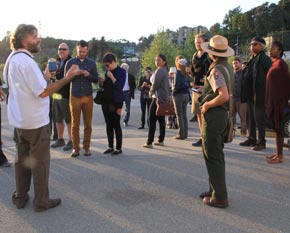News
A Walk in the Park
Professor Fabian Wagmister unveils an experimental mobile website for the Los Angeles State Historic Park

On Thursday, Oct. 16, Associate Professor Fabian Wagmister, director of UCLA Center for Research in Engineering, Media and Performance (REMAP) celebrated the public release of LASHP Trails, an experimental mobile website he developed with his team at UCLA REMAP’s Interpretive Media Laboratory (IMLab). The result of 10 years of research and featuring urban paths that explore the past, present and future of the neighborhoods surrounding the Los Angeles State Historic Park (LASHP), the website is the first site-specific historic storytelling environment in Los Angeles. Wellspring, an original, digitally interactive sculpture that serves as the mobile website’s trailhead, was also revealed during an afternoon ceremony that took place under Los Angeles’ North Broadway Bridge and was attended by Peter Marx, chief innovation technology officer for the City of Los Angeles; Craig Sap, Angeles District superintendent for California State Parks, and David Szymanski, superintendent of the Santa Monica Mountains National Recreation Area. Designed in collaboration with artists Michael Parker and Troy Rounseville, Wellspring features interactive light and sound created by IMLab.
LASHP Trails, a partnership between UCLA REMAP, California State Parks, the National Park Service, the California Endowment and the City of Los Angeles, is the evolution of an idea that began with 60 students from Los Angeles’ Franklin High School. In conjunction with staff from the National Parks Service and the Department of City Planning, the students designed urban trails connecting their neighborhoods to LASHP. The students envisioned the park as a “community trailhead” linking downtown, Chinatown, Northeast L.A., and the L.A. River with a healthy system of pedestrian and non-motorized transportation opportunities within a 650-acre area surrounding the park.
“Because of my extensive research in the history of the neighborhoods they were exploring I was invited to speak to them about the area,” Wagmister says. “I was so inspired by their work I immediately started imagining a flexible digital media tool to allow many community groups to do their own interactive trails.”
Wagmister and UCLA REMAP executive director Jeff Burke developed the concept of a mobile website that intensifies users’ “connection to place” by exposing them to the often-hidden history and potential futures of the spaces in which they are physically standing. In doing so, Wagmister says, “we hope to make people more aware of the process of urban transformation, promote their civic engagement and empower them to participate.” (Through the years, Wagmister adds, more than 30 student researchers contributed to the creation of the content. An “innumerable amount of community partners and members” were also instrumental in its creation, by sharing images and stories about their neighborhoods.) LASHP Trails marks one of IMLab’s initial efforts to connect place-based content with the promotion of physical activity through urban trails near the park.
LASHP Trails is just the beginning. Wagmister and his team are already working on a much larger project that would enable community groups throughout the city to “create interconnected trails based on their identity, their needs and their aspirations,” he says. “We hope such a system will connect with the city and with our fellow Angelinos.”
Posted: October 17, 2014





